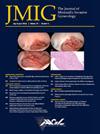荷兰全国性多中心前瞻性队列研究了取出手术后与 Essure 相关的症状。
IF 3.3
2区 医学
Q1 OBSTETRICS & GYNECOLOGY
引用次数: 0
摘要
研究目的Essure 是一种宫腔镜绝育装置,自 2003 年起在荷兰开始使用。由于许多与该装置相关的症状报道,Essure受到了广泛关注。因此,越来越多的患者要求通过手术取出 Essure 装置。关于摘除手术对报告症状和患者满意度的影响,目前可用的数据还很有限。本研究旨在分析 Essure 移除手术对报告症状和生活质量的影响:设计:荷兰多中心前瞻性研究:环境: 二级非教学医院、二级和三级教学医院:干预措施:要求参与者填写调查问卷:干预措施:要求参与者在首次就诊时、移除手术后 3 个月和 12 个月填写调查问卷。调查问卷包括有关患者特征、症状和生活质量(SF-36)的问题。临床医生也填写了两份问卷,内容涉及围手术期结果、切除手术和术后恢复:在2016年5月至2019年4月期间,纳入了32家医院的1248名患者。平均年龄为 42.9 岁(25-63 岁)。最常报告的症状是情绪波动(72.4%)、疲劳(71.8%)、臀部、腿部或腹股沟疼痛(68.3%)和腹痛(62.3%)。Essure 主要通过腹腔镜输卵管切除术取出(87.3%)。平均随访时间为 17 个月(± 10.8)。移除手术后 3 个月和 12 个月,所有报告的症状均明显改善。生活质量在所有 9 个方面都有明显改善:结论:Essure 移除手术与症状和生活质量的改善有关。出现 Essure 相关症状的患者,在考虑了患者的具体手术风险后,应接受 Essure 移除手术。本文章由计算机程序翻译,如有差异,请以英文原文为准。
Dutch Nationwide Multicenter Prospective Cohort of Essure-Related Symptomatology After Removal Surgery
Study Objective
Essure is a hysteroscopic sterilization device that has been used in the Netherlands since 2003. Essure has received a lot of publicity due to many reported symptoms associated with the device. Because of this, increasing numbers of patients requested surgical removal of Essure devices. There is still limited data available regarding the effect of removal surgery on reported symptoms and patient satisfaction. The aim of this study was to analyze the effect of Essure removal surgery on reported symptoms and quality of life (QoL).
Design
Multicenter prospective study in the Netherlands.
Setting
Secondary non-teaching hospitals and secondary and tertiary teaching hospitals.
Patients
Patients with Essure-associated symptoms and a request for surgical removal of devices.
Interventions
Participants were asked to fill out questionnaires at their first clinic visit and 3 and 12 months after removal surgery. Questionnaires included questions regarding patient characteristics, symptoms, and QoL (SF-36). Clinicians also filled in 2 questionnaires regarding peroperative findings, the removal surgery, and post-operative recovery.
Measurements and Main Results
A total of, 1248 patients in 32 hospitals were included in the period between May 2016 and April 2019. Mean age was 42.9 years (25–63 years). Most frequent reported symptoms were mood swings (72.4%), fatigue (71.8%), pain in hips, legs, or groins (68.3%) and abdominal pain (62.3%). Essure was predominantly removed by laparoscopic salpingectomy (87.3%). Mean follow-up time was 17 months (± 10.8). 3 and 12 months after removal surgery, all reported symptoms significantly improved. QoL improved significantly in all 9 domains.
Conclusion
Essure removal surgery was associated with improvement in reported symptoms and QoL. Patients presenting with Essure-related symptoms, should be offered Essure removal surgery, after considering the patient-specific risks for surgery.
求助全文
通过发布文献求助,成功后即可免费获取论文全文。
去求助
来源期刊
CiteScore
5.00
自引率
7.30%
发文量
272
审稿时长
37 days
期刊介绍:
The Journal of Minimally Invasive Gynecology, formerly titled The Journal of the American Association of Gynecologic Laparoscopists, is an international clinical forum for the exchange and dissemination of ideas, findings and techniques relevant to gynecologic endoscopy and other minimally invasive procedures. The Journal, which presents research, clinical opinions and case reports from the brightest minds in gynecologic surgery, is an authoritative source informing practicing physicians of the latest, cutting-edge developments occurring in this emerging field.

 求助内容:
求助内容: 应助结果提醒方式:
应助结果提醒方式:


